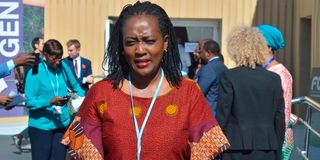Anything missing at COP27? Women's voices

Environment CS Soipan Tuya at the COP27 Climate Conference at Sharm El-Sheikh City in Egypt on November 12, 2022. A study by IUCN conducted last year, showed that only 15 per cent of ministers holding the environment docket globally, are women.
What you need to know:
- More than 20 years since the first Conference of Parties (COP) was held, less than five women have been COP presidents.
- Women are now calling for greater representation at the 28th Conference of Parties (COP28).
- The trend of underrepresentation makes women's issues on climate change have fewer voices to support their needs.
- Environment CS Soipan Tuya, says Kenya is on course to implement the Gender Action Plan.
"Notice Anyone Missing?" is a caption of a photo of global leaders attending the 27th Conference of Parties (COP27) doing rounds on social media, indicating the disparity of women representation at the top level during the summit.
More than 20 years since the first Conference of Parties (COP) was held, less than five women have been COP presidents. Even as the precedent was set in the first COP where former German Chancellor Angela Merkel was President, men continue to dominate the presidency, which is rotational in every region.
Women attending yesterday’s summit in Sharm El-Sheikh, whose theme was gender, raised the issue yesterday.
Each day at the COP has a specific theme that every discussion and side events focus on.
Women are now calling for greater representation at the 28th Conference of Parties (COP28), suggesting that the United Arab Emirates, which will be the host, to select a female president.
Fewer voices
While progress seems to have been made by countries sending female representatives as part of the delegation, Elise Buckle, co-founder of She Changes Climate, said it is disappointing to have less than 10 of the about 110 heads of state who attended the conference, being female.
She argued that the trend of underrepresentation makes women issues on climate change, which are key to ensure resilience, to have fewer voices to support their needs.
Environment Cabinet Secretary Soipan Tuya, who was part of a panel addressing the need for inclusion of voices of women as climate leaders, said Kenya is on course to implement the Gender Action Plan.
The United Nations Framework Convention on Climate Change (UNFCCC) first recognized the nexus between gender and climate change in the year 2001.
According to the UNFCCC, a Gender Action Plan is one that focuses on five key areas that promote gender equity in climate related issues.
In 2020 at the 25th Conference of Parties (COP25), countries agreed to have a five-year Gender Action Plan to scale up the needs for women in response to the climate crisis.
Women's needs
In an interview with Nation.Africa, Anne Songole, the Climate Change Coordinator at Femnet Kenya, said women’s participation should be encouraged in the formulation of policies at national and sub-national level.
“The Gender Action Plan needs to be financed and women be involved because it has key elements on monitoring and reporting, awareness creation and so it will serve as a benefit to women’s needs,” she said.
Ms Songole also reiterated that in all the Sustainable Development Goals (SDGs), none of those has achieved gender equality and women are largely undersold.
“We need to encourage grassroots participation of women in forums such as the COP and the government in collaboration with embassies, should help in fast-tracking their visas should an opportunity arise. Women, girls and indigenous communities are critical to ensuring that no one gets no one behind.” she added.
Climate Activist Elizabeth Wathuthi, shared a passionate story of her visit to Wajir County where she saw, first-hand, how women and girls are adversely affected by the impacts of climate change.
"We are not doing enough to centre the voices of women and their lived experiences on climate change. If we talk about energy, then we need their voices to be part of the solution. It is important that they be represented in key meetings such as this. Already, this COP has missed the mark as fewer women from communities affected by climate change are here,” said Wathuthi.
Traditional ways
Director Ecosystem Division at the United Nations Environment Program Susan Gardner, said women need to be embedded in such meetings because they have the knowledge and understanding on what is needed to adapt to the natural environment since most of them are aware of local and traditional ways to adapt to climate change.
A study by the International Union for Conservation of Nature (IUCN) conducted last year, showed that only 15 per cent of ministers holding the environment docket globally, are women.
“Now, more than ever, concerted efforts to close gaps and increase gender equality for better, impactful environmental decision-making and action will be critically important to ensure the resiliency of communities to overcome our global climate change and biodiversity challenges and achieve our global goals and build back better together,” highlighted the IUCN report.
This disparity is also in the research field where data from the International Centre for the Study of Research shows that about 20 per cent of studies related to climate change are written by female scientists.
Data from Unesco Institute of Statistics also indicates that less than 30 per cent of the world’s researchers are women.
Women attending the COP27 now want this to change and the discussions on the Gender Day at different pavilions attended by this writer centred on inclusion of women in different aspects of climate change discourse.
This article was produced courtesy of the Climate Tracker Fellowship





